Contents
Youth Sports Nonprofit Business Plan
In the Richmond Metro area, only 25% of youth participated in organized sports last year, compared to 85-90% in the suburbs, as stated in State University’s recent report on Richmond’s Youth Sport Need Assessment. Currently, there are 40,000 children aged 6-14 in the Richmond Metro area. Unlike the suburbs, the metro area lacks a comprehensive range of youth sports programs with sufficient financial backing. This delayed introduction to organized sports has particularly negative implications for urban girls, as it denies them the chance to engage in physical activity, receive coaching, be part of a team, learn skills, and avoid engaging in "negative recreation" such as drugs, violence, or sexual activities.
Clinical studies have shown that sports and recreation programs can help establish lifelong, healthy physical activity patterns in youth. Regular physical activity helps prevent life-threatening diseases, reduces feelings of depression and anxiety, maintains a healthy weight, and promotes healthy bones, muscles, and joints, according to the President’s Council on Physical Fitness.
Regardless of age, race, gender, family composition, income, or community, children in the city’s core must have equal opportunities in education and sports from the start. In response to this significant disparity, YouthSports aims to provide the necessary sports programs for Richmond children, ensuring equal access to organized sports.
Thanks to a three-year matching grant from The John Ford Stevenson Foundation (JFSF), YouthSports, along with corporate partners, plans to utilize organized sports and physical activity programs to promote healthy youth development.
The JFSF, based in San Francisco, CA, is the nation’s largest philanthropy devoted to health care. Its grantmaking focuses on three goals: ensuring access to basic health care at reasonable cost, improving care and support for people with chronic health conditions, and reducing personal, social, and economic harm caused by substance abuse, including tobacco, alcohol, and illicit drugs.
Schools and health care centers will handle sport registration, as they have a clear understanding of their communities’ needs. Along with matching contributions from local partners, the JFSF renewable matching grant will provide substantial funding for the project.
The collaborating partners include:
- BlueCross/BlueShield
- Mayor Linda Hargrove and the City of Richmond
- Parks & Recreation Department
- Richmond Unified School District
- Templex Corporation
- A.I. Kaufman and Sons
- PriceRight Supermarkets
- Avion Computers
- The Richmond Mall
- Richmond Bank
- Rider Corporation
With this support base, YouthSports will raise additional funds through program sponsorship and fundraising campaigns.
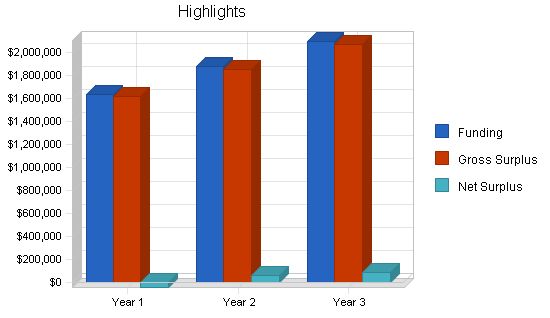
1.1 Objectives
- Increase participation in youth sports and recreation programs in the Richmond Metro area.
- Increase youth access to health care and healthy development.
1.2 Mission
The mission of YouthSports is to create a youth sport program in the Richmond Metro area, increasing sport participation rates and promoting healthy development of youth.
1.3 Keys to Success
- Utilize the school system to promote the sports program and recruit team coaches.
- Minimize field maintenance and facility costs with the school and city park systems.
- Maintain the City Council’s support to provide scholarship funds for needy youth who want to participate in sports.
- Recruit corporate support for the sports program.
- Maintain a high approval rate with parents and youth in the area.
Organization Summary
YouthSports will be a private, non-profit youth sports program serving children, ages 6-14, in the Richmond Metro area. The program aims to promote youth sports participation, healthy development, and increase access to health care.
YouthSports has rented office space near the city cent park system. Outdoor sports will be played on public school and park property, while indoor sports will be played in public school gyms.
2.1 Start-up Summary
Start-up costs and initial financing are shown in the following tables and chart.
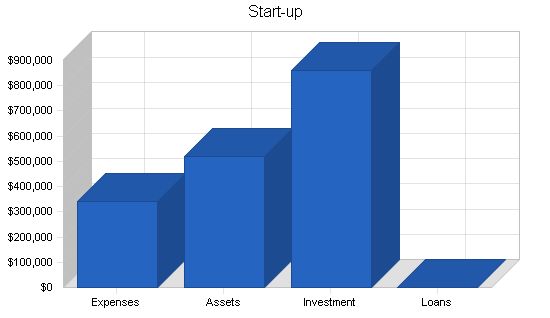
Start-up Funding:
Start-up Expenses to Fund: $342,000
Start-up Assets to Fund: $518,000
Total Funding Required: $860,000
Assets:
Non-cash Assets from Start-up: $250,000
Cash Requirements from Start-up: $268,000
Additional Cash Raised: $0
Cash Balance on Starting Date: $268,000
Total Assets: $518,000
Liabilities and Capital:
Liabilities:
Current Borrowing: $0
Long-term Liabilities: $0
Accounts Payable (Outstanding Bills): $0
Other Current Liabilities (interest-free): $0
Total Liabilities: $0
Capital:
Planned Investment:
JFSF: $430,000
Blue Shield/Blue Cross: $100,000
Templex Corporation: $25,000
A.I. Kaufman and Sons: $25,000
PriceRight Supermarkets: $80,000
Avion Computers: $50,000
The Richmond Mail: $50,000
Richmond Bank: $50,000
Rider Corporation: $50,000
Other: $0
Additional Investment Requirement: $0
Total Planned Investment: $860,000
Loss at Start-up (Start-up Expenses): ($342,000)
Total Capital: $518,000
Total Capital and Liabilities: $518,000
Total Funding: $860,000
Start-up Requirements:
Start-up Expenses:
Legal: $5,000
Stationery etc.: $5,000
Brochures: $20,000
Promotion: $100,000
Insurance: $10,000
Rent: $2,000
Research and Development: $0
Sport Equipment: $100,000
Office Equipment/Software: $100,000
Other: $0
Total Start-up Expenses: $342,000
Start-up Assets:
Cash Required: $268,000
Other Current Assets: $50,000
Long-term Assets: $200,000
Total Assets: $518,000
Total Requirements: $860,000
Services:
YouthSports will offer the following sports during the year:
– Flag Football, August-November.
– 1st/2nd Grade Basketball, October-December.
– 3rd-8th Grade Basketball, December-March.
– Spring Soccer, March-May.
– T-Ball/Softball/Baseball, May-July.
Market Analysis Summary:
There are 40,000 children in the Richmond Metro area between six to 14 years of age. The age group percentages break down as follows:
– 50% – Ages 6-8.
– 30% – Ages 9-11.
– 20% – Ages 12-14.
Currently, only 10% of 6 -11 year olds in the Richmond Metro area participate in organized sports. More importantly, only 5% of girls in that age group are involved in sports. The current age breakdown provides YouthSports with an excellent opportunity to impact half of our target group at the youngest ages. This will have a tremendous impact on the success of the program over the next five years.
It is also important to note that there are over 25,000 children in the Richmond Metro area between the ages of two to five. These children will be entering the YouthSports program within the next three years.
Market Segmentation:
The 2-5 and 6-8 age groups represent over 70% of the children that YouthSports will serve over the next three years. It is critical that the program is prepared to manage the influx of these young children.
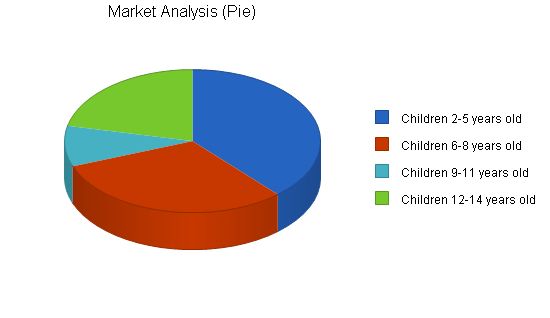
Market Analysis
| Market Analysis | |||||||
| 1 | 2 | 3 | 4 | 5 | |||
| Potential Customers | Growth | CAGR | |||||
| Children 2-5 years old | 8% | 25,000 | 27,000 | 29,160 | 31,493 | 34,012 | 8.00% |
| Children 6-8 years old | 10% | 20,000 | 22,000 | 24,200 | 26,620 | 29,282 | 10.00% |
| Children 9-11 years old | 10% | 6,000 | 6,600 | 7,260 | 7,986 | 8,785 | 10.00% |
| Children 12-14 years old | 8% | 14,000 | 15,120 | 16,330 | 17,636 | 19,047 | 8.00% |
| Total | 8.81% | 65,000 | 70,720 | 76,950 | 83,735 | 91,126 | 8.81% |
Strategy and Implementation Summary
YouthSports must take a proactive approach in promoting its program and implementing a strong fundraising program. To achieve these goals, two groups will oversee the program’s growth and development. A 12-member Program Services Group, comprising of community members, will provide oversight of service delivery and build community support. A 10-member Finance Group, consisting of Richmond business representatives, will oversee fiscal operations and fundraising activities.
The next step will be recruiting volunteer coaches and facility supervisors for each season, utilizing community churches, civic organizations, and the Richmond Police Department. YouthSports is also partnering with the Community Service Program of State University to recruit college students as coaches, who will receive university credits for their involvement.
Mobilizing a coaching/supervision base will enable YouthSports to reach the entire community with its message.
Streamlining the sign-up process will involve providing participation forms at schools and community markets, with collection kiosks available at each location.
5.1 Competitive Edge
YouthSports has a twofold competitive edge. First, it has the support of the community’s public resources, which will contribute to a successful sports program that positively impacts the area’s children. The school district is committed to promoting the sports program, with each school choosing a team name and allowing volunteer coaches to visit classrooms. The city park system has also played a crucial role by providing discounted sports equipment.
Second, local businesses are supporting YouthSports, recognizing the opportunity to make a real impact on the metro youth. The revitalization of Richmond’s urban center relies on improving the quality of life for metro residents, particularly the majority of children under the age of six. Businesses are eager to become sport and school team sponsors.
To develop effective business strategies, a SWOT analysis is recommended. Our free guide and template can assist you in performing a SWOT analysis.
5.2 Fundraising Strategy
YouthSports will focus its fundraising efforts on two groups: metro area parents and Richmond’s businesses. Success with both groups is essential for the program’s future.
Metro Area Parents: While sign-up fees will only cover 30% of operating costs, they are crucial for several reasons. Firstly, they create a sense of ownership in the program, fostering long-term community support. Secondly, the monetary commitment generates expectations of high-quality services, stimulating the program’s responsiveness to community needs. Lastly, the fees serve as an organizing tool to recruit volunteers who will work for the program as part of a child scholarship agreement.
5.2.1 Funding Forecast
Here is the funding forecast for the next three years.
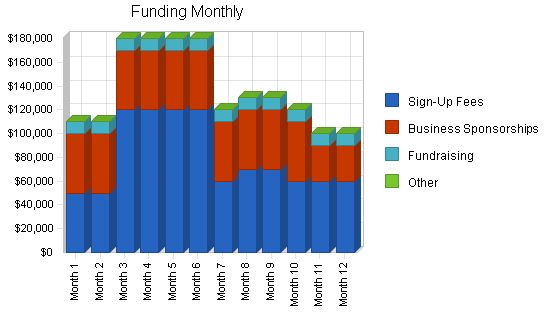
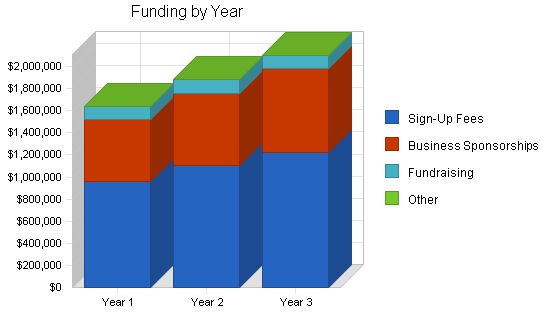
Funding Forecast
Year 1 Year 2 Year 3
Funding
Sign-Up Fees $960,000 $1,100,000 $1,220,000
Business Sponsorships $560,000 $660,000 $760,000
Fundraising $120,000 $120,000 $120,000
Other $0 $0 $0
Total Funding $1,640,000 $1,880,000 $2,100,000
Direct Cost of Funding
Year 1 Year 2 Year 3
Sign-Up Fees $0 $0 $0
Business Sponsorships $12,000 $15,000 $18,000
Fundraising $12,000 $12,000 $12,000
Other $0 $0 $0
Subtotal Cost of Funding $24,000 $27,000 $30,000
Management Summary
YouthSports will establish a team to manage the program’s day-to-day operations.
6.1 Personnel Plan
The program team will consist of the following positions:
– Director
– Assistant Director
– Volunteer Coordinator
– Sponsorship/Fundraising Developer
– Facility Coordinator
– Coordinator of Game Officials
– Area Supervisors (3)
– Office Manager
– Clerical Staff (2)
Personnel Plan
Year 1 Year 2 Year 3
Director $36,000 $39,000 $42,000
Assistant Director $31,200 $34,000 $37,000
Volunteer Coordinator $30,000 $33,000 $36,000
Sponsorship/Fundraising Developer $33,600 $37,000 $40,000
Facility Coordinator $30,000 $33,000 $36,000
Coordinator of Game Officials $28,800 $31,000 $34,000
Area Supervisors (3) $72,000 $80,000 $90,000
Office Manager $30,000 $33,000 $36,000
Clerical Staff (2) $38,400 $41,000 $44,000
Total People 12 12 12
Total Payroll $330,000 $361,000 $395,000
The following is the Financial Plan for YouthSports for three years.
The following table and chart illustrate the Break-even Analysis for YouthSports.
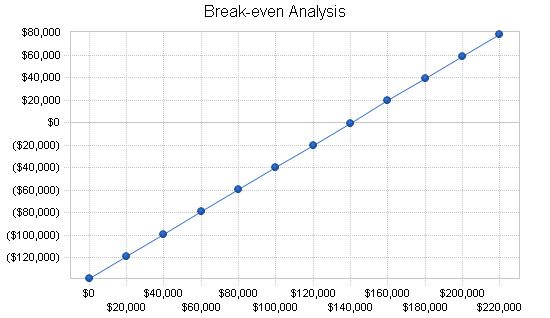
Break-even Analysis:
Monthly Revenue Break-even: $140,548.
Assumptions:
– Average Percent Variable Cost: 1%.
– Estimated Monthly Fixed Cost: $138,492.
Projected Surplus or Deficit:
The program’s operation surplus or deficit for three years is as follows:
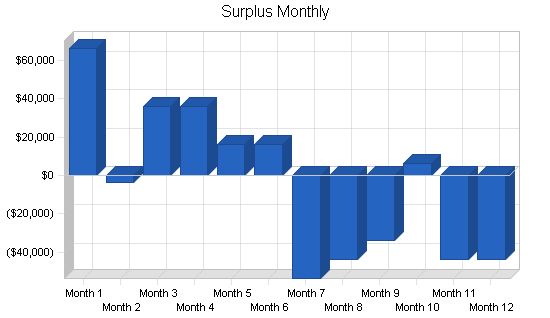
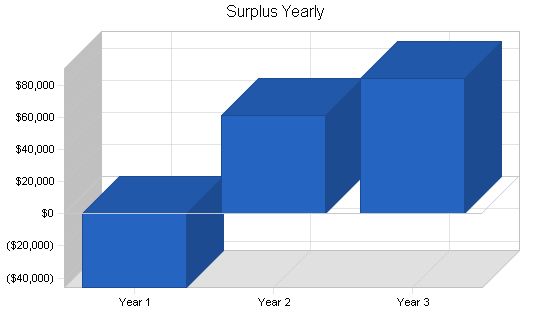
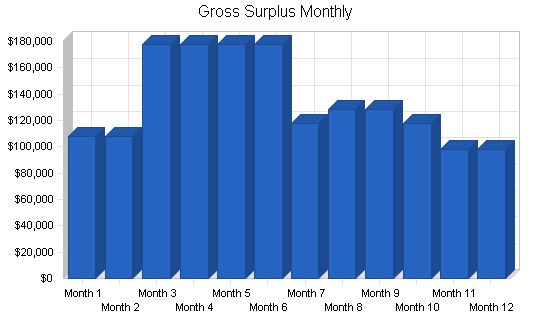
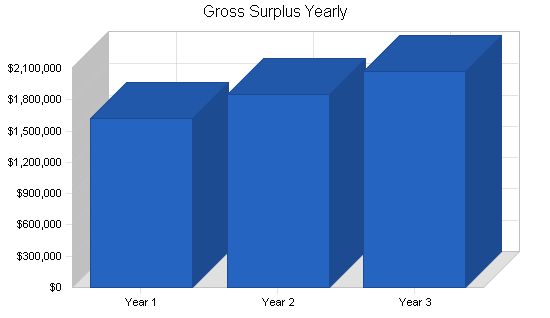
Surplus and Deficit:
Year 1 Year 2 Year 3
Funding: $1,640,000 $1,880,000 $2,100,000
Direct Cost: $24,000 $27,000 $30,000
Other Production Expenses: $0 $0 $0
Total Direct Cost: $24,000 $27,000 $30,000
Gross Surplus: $1,616,000 $1,853,000 $2,070,000
Gross Surplus %: 98.54% 98.56% 98.57%
Expenses:
Payroll: $330,000 $361,000 $395,000
Sales and Marketing and Other Expenses: $1,196,000 $1,290,000 $1,445,000
Depreciation: $0 $0 $0
Leased Equipment: $0 $0 $0
Utilities: $2,400 $2,400 $2,400
Insurance: $60,000 $60,000 $60,000
Rent: $24,000 $24,000 $24,000
Payroll Taxes: $49,500 $54,150 $59,250
Other: $0 $0 $0
Total Operating Expenses: $1,661,900 $1,791,550 $1,985,650
Surplus Before Interest and Taxes: ($45,900) $61,450 $84,350
EBITDA: ($45,900) $61,450 $84,350
Interest Expense: $0 $0 $0
Taxes Incurred: $0 $0 $0
Net Surplus: ($45,900) $61,450 $84,350
Net Surplus/Funding: -2.80% 3.27% 4.02%
Projected Cash Flow:
The following is the Projected Cash Flow of the program’s operation for three years.
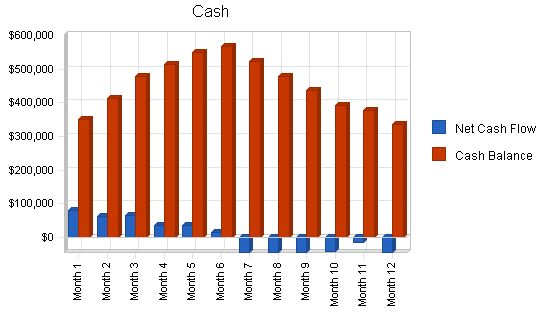
Pro Forma Cash Flow
Cash Received
Cash from Operations
Cash Funding
Subtotal Cash from Operations
Additional Cash Received
Sales Tax, VAT, HST/GST Received
New Current Borrowing
New Other Liabilities (interest-free)
New Long-term Liabilities
Sales of Other Current Assets
Sales of Long-term Assets
New Investment Received
Subtotal Cash Received
Expenditures
Expenditures from Operations
Cash Spending
Bill Payments
Subtotal Spent on Operations
Additional Cash Spent
Sales Tax, VAT, HST/GST Paid Out
Principal Repayment of Current Borrowing
Other Liabilities Principal Repayment
Long-term Liabilities Principal Repayment
Purchase Other Current Assets
Purchase Long-term Assets
Dividends
Subtotal Cash Spent
Net Cash Flow
Cash Balance
Projected Balance Sheet
Pro Forma Balance Sheet
Assets
Current Assets
Cash
Other Current Assets
Total Current Assets
Long-term Assets
Long-term Assets
Accumulated Depreciation
Total Long-term Assets
Total Assets
Liabilities and Capital
Current Liabilities
Accounts Payable
Current Borrowing
Other Current Liabilities
Subtotal Current Liabilities
Long-term Liabilities
Total Liabilities
Paid-in Capital
Accumulated Surplus/Deficit
Surplus/Deficit
Total Capital
Total Liabilities and Capital
Net Worth
Standard Ratios
Ratio Analysis
Funding Growth
Percent of Total Assets
Other Current Assets
Total Current Assets
Long-term Assets
Total Assets
Current Liabilities
Long-term Liabilities
Total Liabilities
Net Worth
Percent of Funding
Funding
Gross Surplus
Selling, General & Administrative Expenses
Advertising Expenses
Surplus Before Interest and Taxes
Main Ratios
Current
Quick
Total Debt to Total Assets
Pre-tax Return on Net Worth
Pre-tax Return on Assets
Additional Ratios
Net Surplus Margin
Return on Equity
Activity Ratios
Accounts Payable Turnover
Payment Days
Total Asset Turnover
Debt Ratios
Debt to Net Worth
Current Liab. to Liab.
Liquidity Ratios
Net Working Capital
Interest Coverage
Additional Ratios
Assets to Funding
Current Debt/Total Assets
Acid Test
Funding/Net Worth
Dividend Payout
Appendix
Funding Forecast
Funding
Sign-Up Fees
Business Sponsorships
Fundraising
Other
Total Funding
Direct Cost of Funding
Sign-Up Fees
Business Sponsorships
Fundraising
Other
Subtotal Cost of Funding
Personnel Plan
Director: 0% – $3,000 (per month)
Assistant Director: 0% – $2,600 (per month)
Volunteer Coordinator: 0% – $2,500 (per month)
Sponsorship/Fundraising Developer: 0% – $2,800 (per month)
Facility Coordinator: 0% – $2,500 (per month)
Coordinator of Game Officials: 0% – $2,400 (per month)
Area Supervisors (3): 0% – $6,000 (per month)
Office Manager: 0% – $2,500 (per month)
Clerical Staff (2): 0% – $3,200 (per month)
Total People: 12
Total Payroll: $27,500
General Assumptions
Plan Month: 1, 2, 3, 4, 5, 6, 7, 8, 9, 10, 11, 12
Current Interest Rate: 10.00%
Long-term Interest Rate: 10.00%
Tax Rate: 0.00%
Other: 0
Surplus and Deficit
Funding: $110,000, $110,000, $180,000, $180,000, $180,000, $180,000, $120,000, $130,000, $130,000, $120,000, $100,000, $100,000
Direct Cost: $2,000, $2,000, $2,000, $2,000, $2,000, $2,000, $2,000, $2,000, $2,000, $2,000, $2,000, $2,000
Other Production Expenses: $0, $0, $0, $0, $0, $0, $0, $0, $0, $0, $0, $0
Total Direct Cost: $2,000, $2,000, $2,000, $2,000, $2,000, $2,000, $2,000, $2,000, $2,000, $2,000, $2,000, $2,000
Gross Surplus: $108,000, $108,000, $178,000, $178,000, $178,000, $178,000, $118,000, $128,000, $128,000, $118,000, $98,000, $98,000
Gross Surplus %: 98.18%, 98.18%, 98.89%, 98.89%, 98.89%, 98.89%, 98.33%, 98.46%, 98.46%, 98.33%, 98.00%, 98.00%
Expenses
Payroll: $27,500, $27,500, $27,500, $27,500, $27,500, $27,500, $27,500, $27,500, $27,500, $27,500, $27,500, $27,500
Sales and Marketing and Other Expenses: $3,000, $73,000, $103,000, $103,000, $123,000, $123,000, $133,000, $133,000, $123,000, $73,000, $103,000, $103,000
Depreciation: $0, $0, $0, $0, $0, $0, $0, $0, $0, $0, $0, $0
Leased Equipment: $0, $0, $0, $0, $0, $0, $0, $0, $0, $0, $0, $0
Utilities: $200, $200, $200, $200, $200, $200, $200, $200, $200, $200, $200, $200
Insurance: $5,000, $5,000, $5,000, $5,000, $5,000, $5,000, $5,000, $5,000, $5,000, $5,000, $5,000, $5,000
Rent: $2,000, $2,000, $2,000, $2,000, $2,000, $2,000, $2,000, $2,000, $2,000, $2,000, $2,000, $2,000
Payroll Taxes: 15% – $4,125, $4,125, $4,125, $4,125, $4,125, $4,125, $4,125, $4,125, $4,125, $4,125, $4,125, $4,125
Other: $0, $0, $0, $0, $0, $0, $0, $0, $0, $0, $0, $0
Total Operating Expenses: $41,825, $111,825, $141,825, $141,825, $161,825, $161,825, $171,825, $171,825, $161,825, $111,825, $141,825, $141,825
Surplus Before Interest and Taxes: $66,175, ($3,825), $36,175, $36,175, $16,175, $16,175, ($53,825), ($43,825), ($33,825), $6,175, ($43,825), ($43,825)
EBITDA: $66,175, ($3,825), $36,175, $36,175, $16,175, $16,175, ($53,825), ($43,825), ($33,825), $6,175, ($43,825), ($43,825)
Interest Expense: $0, $0, $0, $0, $0, $0, $0, $0, $0, $0, $0, $0, $0
Taxes Incurred: $0, $0, $0, $0, $0, $0, $0, $0, $0, $0, $0, $0, $0
Net Surplus: $66,175, ($3,825), $36,175, $36,175, $16,175, $16,175, ($53,825), ($43,825), ($33,825), $6,175, ($43,825), ($43,825)
Net Surplus/Funding: 60.16%, -3.48%, 20.10%, 20.10%, 8.99%, 8.99%, -44.85%, -33.71%, -26.02%, 5.15%, -43.83%, -43.83%
Pro Forma Cash Flow
Cash Received
Cash from Operations
Cash Funding
Subtotal Cash from Operations
Additional Cash Received
Sales Tax, VAT, HST/GST Received
New Current Borrowing
New Other Liabilities (interest-free)
New Long-term Liabilities
Sales of Other Current Assets
Sales of Long-term Assets
New Investment Received
Subtotal Cash Received
Expenditures
Expenditures from Operations
Cash Spending
Bill Payments
Subtotal Spent on Operations
Additional Cash Spent
Sales Tax, VAT, HST/GST Paid Out
Principal Repayment of Current Borrowing
Other Liabilities Principal Repayment
Long-term Liabilities Principal Repayment
Purchase Other Current Assets
Purchase Long-term Assets
Dividends
Subtotal Cash Spent
Net Cash Flow
Cash Balance
Pro Forma Balance Sheet
Assets
Starting Balances
Current Assets
Cash
Other Current Assets
Total Current Assets
Long-term Assets
Long-term Assets
Accumulated Depreciation
Total Long-term Assets
Total Assets
Liabilities and Capital
Current Liabilities
Accounts Payable
Current Borrowing
Other Current Liabilities
Subtotal Current Liabilities
Long-term Liabilities
Total Liabilities
Paid-in Capital
Accumulated Surplus/Deficit
Surplus/Deficit
Total Capital
Total Liabilities and Capital
Net Worth
Hello!
I’m Andrew Brooks, a seasoned finance consultant from the USA and the mind behind phonenumber247.com.
My career is built on a foundation of helping individuals and businesses thrive financially in an ever-changing economic landscape. At phonenumber247.com, my aim is to demystify the complex world of finance, providing clear, actionable advice that can help you navigate your financial journey with confidence. Whether it’s personal finance management, investment strategies, or understanding the nuances of market dynamics, I’m here to share insights and tools that can propel you towards your financial goals.
Welcome to my digital space, where every piece of advice is a step closer to financial clarity and success!
